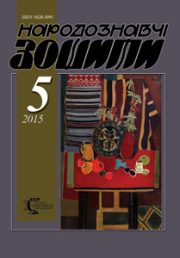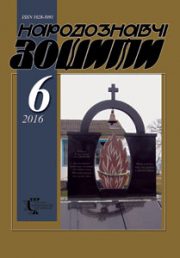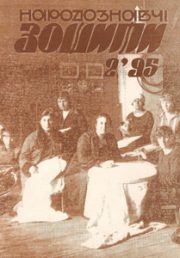The Ethnology Notebooks. 2022. № 4 (166), 764—789
UDK [[39+37]-057.4:929(477.83-25)”188/195″П.Мечник]:930.2
DOI https://doi.org/10.15407/nz2022.04.764
HILEVYCH Ihor
- ORCID ID: https://orcid.org/0000-0002-4405-2588
- Candidate of Historical Sciences (= Ph. D. in history),
- Associate Professor of the Department of Ethnology,
- Ivan Franko National University of Lviv,
- 1, Universytetska Str., 79000, Lviv, Ukraine,
- Contacts: e-mail: ihor.hilevych@lnu.edu.ua
Abstract. From 1910 to 1944, Petro Mechnyk was one of the Ukrainian nationally conscious high school professors of Lviv, contributed a lot to the education of several generations of Ukrainian youth, was among the popularizers of the use of psychotechnical methods for schoolchildren’s choice of future profession.
He ended up in the mid-1940s in the State Ethnographic Museum of the Academy of Sciences of the Ukrainian SSR, was a professional teacher and psychologist who looked at the phenomena of the traditional culture of Ukrainians, in particular the Hutsuls, through the prism of psychology as a science. Such an approach in the future could give new interesting results, but, unfortunately, it did not correspond at all to the uniform scientific methodology that the Soviet authorities at that time forcibly introduced in Ukrainian humanitarianism, in particular ethnology.
The study of the traditional funeral rites of the Hutsuls became the central topic of his individual scientific studies during the period of work at the Museum. The spiritual culture of the Hutsuls became, however, the planned comprehensive study was never completed. The archive preserved a typescript of a fragment of this work – a scientific article “The Hutsul funeral rite and the theory of the revival of primitivism”, with which the scientist spoke at the anniversary session in the Museum in December 1945. This work fully deserves to be introduced into scientific circulation as a valuable monument of Ukrainian ethnological science of the mid-1940s.
In the proposed biographical study, special attention is paid to the characteristics of P. Mechnyk’s publications in the field of psychology and pedagogy of the interwar period, in order to show his wide familiarity with a number of problems, the newest at that time Western European and partly North American literature, the presence of his own work, experience in using the questionnaire method, in order to show his plans to apply his previous experience to the study of Hutsul spiritual culture. He looked at the latter not only as an ethnologist, but also as a psychologist, and his only partially realized research had a pronounced interdisciplinary character.
Keywords: Petro Mechnyk, ethnology, pedagogy, psychology, Hutsuls, rituals, history of ethnological science.
Received 25.07.2022
REFERENCES
- Tarnavskyi, R. (2016). Department of Ethnology of Lviv University. Classical period (1910—1947). Lviv: Ivan Franko Lviv National University [in Ukrainian].
- Tarnavskyi, R. (2020). Folk Studies at Lviv University in the late 19th — first half of the 20th century: contexts, discourses, scientific connections. Thesis for the scientific degree of Doctor of Historical Sciences, specialties 07.00.01 — History of Ukraine, 07.00.05 — Ethnology. Qualifying scientific work on the rights of the manuscript. Lviv. Retrieved from: http://surl.li/zczo [in Ukrainian].
- Hilevych, I. (2008). Mustafa Kozakevych as Researcher in Traditional Architecture by Ukrainians of Polisia and Volhynia. The Ethnology notebooks, 3—4, 215—227 [in Ukrainian].
- Hilevych, I. (2013). The life and scientific work of ethnologist, historian and linguist Vasyl Pastushchyn (1889—1958). Visnyk of the Lviv University. Series History (Issue 49, pp. 245—272) (Special Issue) [in Ukrainian].
- Hilevych, I. (2014). Mykhailo Skoryk — etnologist, hіstorian, folklorist. Visnyk of the Lviv University. Series History (Issue 50, pp. 206—243) [in Ukrainian].
- Tsurkan, M.M. (2015). Ethnographic Research in Lviv in the late 30s — 50s of the XX century. Abstract of Thesis for the scientific degree of Candidate of Historical Sciences, specialty: 07.00.05 — Ethnology. Qualifying scientific work on the rights of the manuscript. Lviv [in Ukrainian].
- Kolessa, F., & Koval-Fuchylo, I. (Ed.). (2011). Renewal of Ukrainian ethnography and folklore in the Western regions of the USSR. Kyiv: Lohos [in Ukrainian].
- Senytsia, P., & Romanenchuk, B. (Ed.). (1978). Professors of the Ukrainian Academic Gymnasium. In Centennial book of the First Graduation of the First Ukrainian Academic Gymnazium in Lviv. 1878—1978 (Pp. 121—236). Munchen; Philadelphia [in Ukrainian].
- Hilevych, I. (2014). Mechnyk Petro Ivanovych. Encyclopedia. Ivan Franko National University of Lviv (Vol. ІІ, pp. 131—132). Lviv: Ivan Franko National University of Lviv [in Ukrainian].
- Losyk, O.M. (2018). Mechnyk Petro Ivanovych. Encyclopedia of Modern Ukraine (Vol. 20, pp. 315—316). Kyiv [in Ukrainian].
- Zavgorodnya, T. (2008). Psychological principles of organization of the educational process in schools of Galicia (20—30’s of XX century). In Zavgorodnya, T. Problems of pedagogy: history, modernity, prospects. Collection of scientific works (Pp. 48—55). Ivano-Frankivsk: Publisher Tretyak I.Ya. [in Ukrainian].
- Onishchenko, О.С. (Ed.). (2007). History of the National Academy of Sciences of Ukraine (1941—1945) (Part 2: Appendices). Kyiv [in Ukrainian].
- Onishchenko, О.С. (Ed.). (2008). History of the National Academy of Sciences of Ukraine (1946—1950) (Part. 2: Appendices). Kyiv [in Ukrainian].
- Shakh, S. (1956). Lviv — the city of my youth (Memory, dedicated to the Shadows of Forgotten Lviv) (Part 3: Imperial-Royal Academic Gymnasium). Munich [in Ukrainian].
- Matskiv, T. (1959, June 12). Two memorable dates in the history of the Academic Gymnasium in Lviv. Liberty (Part 112, p. 2) [in Ukrainian].
- Volodymyr, R. (Kukhar, R.V.). (1968, April 2). Thirty years ago (1938 in the Branch of the Academic Gymnasium in Lviv). Liberty (Part 62, p. 3)[in Ukrainian].
- Shcherbatiuk, L. (1968, August 10). Branch, branch (nostalgic) (3). Liberty (Part 146,p. 2) [in Ukrainian].
- Shcherbatiuk, L. (1968, August 15). Branch, branch (nostalgic) (6). Liberty (Part 149, p. 2) [in Ukrainian].
- L-a, M. (1968, September, 26). Our teachers (4). Liberty, 178, 2[in Ukrainian].
- L-a, M. (1968, October 1). Our teachers (6). Liberty, 181, 2 [in Ukrainian].
- Kukhar, R., & Romanenchuk, B. (Ed.). (1978). Ukrainian Academic Gymnazium in Lviv. Centennial book of the First Graduation of the First Ukrainian Academic Gymnazium in Lviv. 1878—1978 (Pp. 49—70). Munchen; Philadelphia [in Ukrainian].
- Oleksyshyn, I., Romanenchuk, B. (Ed.). (1978). Bursa named after Metropolit Sheptytskyi. Centennial book of the First Graduation of the First Ukrainian Academic Gymnazium in Lviv. 1878—1978 (Pp. 367—370). Munchen; Philadelphia [in Ukrainian].
- Kokhanovsky, Z., & Romanenchuk, B. (Ed.). (1978). To the history of UAG during the Second World War. Centennial book of the First Graduation of the First Ukrainian Academic Gymnazium in Lviv. 1878—1978 (Pp. 375—382). Munchen; Philadelphia [in Ukrainian].
- Vynnytskyi, V., & Romanenchuk, B. (Ed.). (1978). The Branch of the UAG in 1939—41. Centennial book of the First Graduation of the First Ukrainian Academic Gymnazium in Lviv. 1878—1978 (Pp. 383—390). Munchen; Philadelphia [in Ukrainian].
- Kostyuk, I., & Romanenchuk, B. (Ed.). (1978). Looking at the scoreboard. Centennial book of the First Graduation of the First Ukrainian Academic Gymnazium in Lviv. 1878—1978 (Pp. 466—479). Munchen; Philadelphia [in Ukrainian].
- Sonevytskyi, M., & Romanenchuk, B. (Ed.). (1978). My memories of the restoration of the Academic Gymnasium in Lviv and its organization in 1941—44. Centennial book of the First Graduation of the First Ukrainian Academic Gymnazium in Lviv. 1878—1978 (Pp. 485—492). Munchen; Philadelphia [in Ukrainian].
- Kukhar, R. (1988, August 9). Fifty years ago in the Branch (The last matura of the humanistic type at the Branch of the Academic Gymnasium in Lviv in 1938). Liberty (Part 150, pp. 2—3)[in Ukrainian].
- Liubinetskyi, Yu. (1994, August 30). Past trails… Liberty (Part 164, p. 2)[in Ukrainian].
- (1997, December 12). Before the takeoff to meet the anniversary of the Academic Gymnasium in Lviv. Liberty (Part 237, p. 4)[in Ukrainian].
- Lew, W. (Ed.). (1980). А commemorative воок: Тhе gymnasium (secondary school) of the Basilian Sisters in Lviv (Vol. ХХІІ). (Shevchenko Scientific Society. Ukrainian Archives). New York; Paris; Sydney; Toronto [in Ukrainian].
- Lew, W. (Ed.). Teachers of the Gymnasium. (1980). А commemorative воок: Тhе gymnasium (secondary school) of the Basilian Sisters in Lviv (Pp. 85—95). New York; Paris; Sydney; Toronto [in Ukrainian].
- Korеnеc, H., & Lew, W. (Ed.). (1980). Оlеnа Stepaniw Dashkewych and «Plast». А commemorative воок: Тhе gymnasium (secondary school) of the Basilian Sisters in Lviv (Pp. 229—242). New York; Paris; Sydney; Toronto [in Ukrainian].
- Leontowych-Bashuk, N., & Lew, W. (Ed.). (1980). The Underground organization (OUN) at the Gymnasium beetween the wars. А commemorative воок: Тhе gymnasium (secondary school) of the Basilian Sisters in Lviv (Pp. 243—246). New York; Paris; Sydney; Toronto [in Ukrainian].
- Lew, W. (Ed.). (1980). The convention of students of the Gymnazium of Sisters of the OSBM in Lviv on the occasion of the fiftieth anniversary of the first class graduation, 12—13 of the September 1964. А commemorative воок: Тhе gymnasium (secondary school) of the Basilian Sisters in Lviv (Pp. 247—252). New York; Paris; Sydney; Toronto [in Ukrainian].
- Moncibowych, A., & Lew, W. (Ed.). (1980). My remembrances about the Gymnasium of the Sisters of the OSBM in Lviv. А commemorative воок: Тhе gymnasium (secondary school) of the Basilian Sisters in Lviv (Pp. 288—292). New York; Paris; Sydney; Toronto [in Ukrainian].
- Tvii, Mykola. (1915, December 11). From the military mood in Ukraine. Liberty (Part 146, p. 2) [in Ukrainian].
- (1925, June 14). Will be notified. Work, 129, 4 [in Ukrainian].
- (1935, May 4). Comrade graduates of the Lviv Academic Gymnasium since 1905. Work (Part 114, p. 6) [in Ukrainian].
- (1927, August 19). To the Ukrainian City. III testimony of victims to the Ukrainian City in Lviv. Work (Part 184, p. 4) [in Ukrainian].
- Yushchyshyn, I. (1933, April 15). Ukrainian council for choosing a title. Work (Part 95, p. 3) [in Ukrainian].
- (1934, February 16). Public lectures on current topics. Work (Part 41, p. 6) [in Ukrainian].
- (1941, July, 10). All the creative forces of the Ukrainian people are united in one common front of the structure of their own state life. Independent Ukraine (Part 3, pp. 1—2) [in Ukrainian].
- (1942, November 2—3). Ukrainian gymnasiums. Lviv news (Part 74, p. 6) [in Ukrainian].
- (1942, July 19—20). Deed worthy of imitation. Lviv news (Part 160, p. 5) [in Ukrainian].
- (1942, September 25). Expression of the donated taxes in the Ukrainian Central Committee for the period from 14.7.1942 to 10.9.1942 on «KoDUS», prisoners, needy and other victims. Lviv news (Part 217, p. 2) [in Ukrainian].
- Archive of Ivan Franko National University of Lviv. Fund R-119. Description 1. Case 121. (Personal file of the senior teacher of the Ukrainian language Mechnyk Petro Ivanovych, 1940) [in Ukrainian].
- Archive of the Institute of Ethnology of the National Academy of Sciences of Ukraine. Fund 1. Description. 1 а (State Ethnographic Museum). Case 6 (Orders № 1—94 director of the museum for 1948. Originals. January 13 — December 20, 1948) [in Ukrainian].
- Archive of the IE NASU. Fund 1. Description. 1 а (SEM). Case 6 (Lists of museum employees for 1944—1950) [in Ukrainian].
- Archive of the IE NASU. Fund 1. Description. 1 а (SEM). Case 4 (Minutes of the meetings of the scientific seminar of the museum for 1944—1947) [in Ukrainian].
- Archive of the IE NASU. Fund 1. Description. 1 а (SEM). Case 11 (Socialist obligations of the museum staff from April 29, 1946) [in Ukrainian].
- Archive of the IE NASU. Fund 1. Description. 1 а (SEM). Case 8 (Mechnyk, P. I. (1945). Hutsul funeral rite and the theory of revival of primitivism) [in Ukrainian].
- Archive of the IE NASU. Fund 1. Description. 1 а (SEM). Case 18 (Acts of acceptance and transfer of the museum when the director of the museum changed in 1948, January 2, 1948) [in Ukrainian].
- Archive of the Andrei Sheptytsky National Museum in Lviv. Case Df-Agu-30. Hurhula, I. Brief description of the work of the Ethnographic Museum of Academy of Sciences of the USSR in Lviv, April 1947 [in Ukrainian].
- Mechnyk, P. (1924). Secret paths of the human spirit. Literary-scientific bulletin (Vol. 83, pp. 328—344) [in Ukrainian].
- Mechnyk, P. (1934). Individual sheet (Part I: Scheme). Lviv: Ridna Shkola [in Ukrainian].
- Mechnyk, P. (1934). Individual sheet (Part II: Instructions to the teacher). Lviv: Ridna Shkola [in Ukrainian].
- Mechnyk, P. (1934). Psychotechnics and its role in professional counseling. Work (Part 218, 220, 222—228 [in Ukrainian].
- Mechnyk, P. (1934). Individual characteristics of school children: Project of «Individual leaflet» with instructions for teachers. Reprint from the pedagogical magazine V.P.U.V. «The path of education and training». Lviv [in Ukrainian].
- Mechnyk, P. (1934). Psychotechnics at the school. Ukrainian school (Part 1—6, pp. 10—21) [in Ukrainian].
- Mechnyk, P. (1923, may 3). May 1, 1920 in Odesa (Several pages of the notebook dedicated to the memory of UGA Ataman A. Garabach). Work (Part 22, p. 2; part 23, pp. 2—3) [in Ukrainian].
- Krysa, L., & Figol, R. (2006). Lychakiv necropolis: a guide. Lviv [in Ukrainian].
- Mykytiuk, D. (Ed.). (1958). Army of the Western Ukraine (Galicia). ln commemoration of the fortieth anniversary of its creation and struggle for the liberation of Ukraine (1918—1920) (Part 1: Winnipeg) [in Ukrainian].
- Lew, W. (Ed.). (1980). Directors of the Gymnasium of the Sisters of the OSBM. А commemorative воок: Тhе gymnasium (secondary school) of the Basilian Sisters in Lviv (Pp. 57—64). New York; Paris; Sydney; Toronto [in Ukrainian].
- Holovyn, B. (2005). Karkhut Spyrydon Vasylovych. Ternopil encyclopedic dictionary: in 4 vol., K—O (Vol. 2, p. 46) [in Ukrainian].
- L-a, M. (1958, July 22). Instead of the Congress. Liberty (Part 138, p. 2)[in Ukrainian].
- Isayiw, P., Kobrynska, A., & Lew, W. (Ed.). (1980). An Outline of the Нistory of the Gymnasium of the Sisters of the OSBM. А commemorative воок: Тhе gymnasium (secondary school) of the Basilian Sisters in Lviv (Pp. 17—35). New York; Paris; Sydney; Toronto [in Ukrainian].
- Нuраlо-Jasincuk, D., & Lew, W. (Ed.). (1980). Му memories about our Gymnasium. А commemorative воок: Тhе gymnasium (secondary school) of the Basilian Sisters in Lviv (Pp. 260—266). New York; Paris; Sydney; Toronto [in Ukrainian].
- Hrytsak, Ye. (2002). Ukrainian pedagogical-school and teacher’s magazines and journals. In Hrytsak, Ye. Selected works of Ukrainian studies. («Peremyshl Library» Peremyshl Branch of the Association of Ukrainians in Poland) (Vol. III, pp. 430—440). Przemysl [in Ukrainian].
- Central State Historical Archive of Ukraine in Lviv. Fund 309 (Shevchenko Scientific Society). Description 1. Case 424. Applications of persons with a request to accept them as members of the society, March 2, 1899 — December 24, 1913 [in Ukrainian].
- Horodyskyi, Z. (1987, October 1). An unforgettable episode from the time of the Soviet occupation of Galicia (in memory of Patriarch Joseph on the third anniversary of his death). Liberty, 188, 2[in Ukrainian].
- Zheleznyak, M. (Ed.). (2018). From the laboratory of creation of the «Encyclopedia of Ukrainian Studies». Kyiv [in Ukrainian].
- (1979, August 24). Honoring the memory of our dearest mother approx. Mr. Neonila from Karhuty Mechnyk. Liberty (Part 192, p. 3)[in Ukrainian].
- Hilevych, I. (2008). Ukrainian ethnology in a post-war decade and the field exploration of Polissia. Visnyk of the Lviv University. Series History (Issue 43, pp. 34—53) [in Ukrainian].
- Symonenko, I.F. (1948). About the time of origin of folk social and household games in Transcarpathia. Materials on ethnography and crafts (Vol. I, pp. 32—45) [in Ukrainian].
- Huzii, R. (2003). The Ethnographic Studies in the Funeral Customary of Ukrainian of Carpathian Region: Some General Direction and Results of Research Works. The Ethnology notebooks, 3—4, 436—445 [in Ukrainian].
- Symonenko, I.F. (1948). Everyday life of the population of the Transcarpathian region (Based on materials from the expeditions of 1945—1947). Soviet ethnography, 1, 63—89 [in Russian].
- Hilevych, I. (2018). Moscow period of activity of the researcher of Carpathians Ivan Symonenko (1943—1949). Fortetsja: zbirnyk zapovidnyka «Tustan’» (Vol. 3, pp. 354—371). Lviv: Prostir-М [in Ukrainian].
- Kuzelia, Z. (1914). Sitting and fun near the deceased in the Ukrainian funeral rite. Memoirs of the Shevchenko Scientific Society (Vol. CXXII, pp. 201—214; Vol. CXXII, pp. 117—127) [in Ukrainian].
- Slezkin, Yu. (1993). The Fall of Soviet Ethnography: 1928—1938. Ethnographic Review, 2, 113—125 [in Russian].
- Solovey, T.D. (2018). From «Bourgeois» Ethnology to «Marxist» Ethnography: Strategies for the Advancement of Marxist Orthodoxy in the Early Soviet Period. History studies. Journal of the History Faculty of Lomonosov State University, 11, 160—178 [in Russian].
- Struve, V.V. (1939). Soviet ethnography and its perspectives. Soviet ethnography: Collection of articles (Issue 2, pp. 3—10). Moscow [in Russian].
- Tolstov, S.P. (1946). Ethnography and modernity. Soviet ethnography, 1, 3—11 [in Russian].
- Tolstov, S.P. (1947). Soviet school in ethnography. Soviet ethnography, 4, 8—28 [in Russian].
- Savchak, V.M. (Ed.). (2009). Rehabilitated by history. In twenty-seven volumes. Lviv region (Book 1). Lviv: Astrolabe [in Ukrainian].
- Hnatiuk, O., & Boianivska, M. (2015). Courage and fear. Kyiv: Spirit and Letter. (Ser. «Library of Resistance, Library of Hope») [in Ukrainian].
- Prystai, O. (2015). Leather and horn treatment (historical background). Folk Art and Ethnology, 1, 84—97 [in Ukrainian].
Read»







